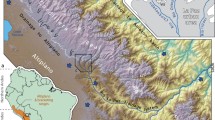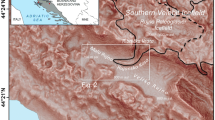Abstract
The Kaigas, Sturtian, Marinoan, and Gaskiers glaciations are widely recognized in Neoproterozoic. However, in the South China Block only the Jiangkou (Sturtian) and Nantuo (Marinoan) are symbolized by sedimentary records. The Kaigas, recorded by isotopic and chemical proxies, exhibited likely the nature of cold paleoclimate with local mountain glaciation. The correlation of the Doushantuo Formation with the Gaskiers is indicated by the carbon isotope excursion and the dated age from the interval, however the South China Block was then under non-glacial weather. With no paleomagnetic data, the position of the South China Block during the Sturtian glaciation cannot be determined. The paleolatitudes of the South China Block during the Kaigas and Nantuo glaciations are intermediate, even though the Nantuo was once rendered erratically deduced equatorial. In fact, the paleolatitudes of the South China Block during the Neoproterozoic glaciations are all likely at about 30°–40°.
Similar content being viewed by others
References
Hoffman P F, Kaufman A J, Halverson G P, et al. A Neoproterozoic snowball Earth. Science, 1998, 281: 1342–1346
Knoll A H, Walter M R, Narbonne G M, et al. A new period for the Geologic Time Scale. Science, 2004, 305: 621–622
Stern R J, Avigad D, Miller N R, et al. Evidence for the snowball Earth hypothesis in the Arabian-Nubian Shield and East African Orogen. J Afr Earth Sci, 2006, 44: 1–20
Zheng Y F, Wu Y B, Gong B, et al. Tectonic driving of Neoproterozoic glaciations: Evidence from extreme oxygen isotope signature of meteoric water in granite. Earth Planet Sci Lett, 2007, 256: 196–210
Maruyama S, Santosh M. Models on Snowball Earth and Cambrian explosion: A synopsis. Gondw Res, 2008, 14: 22–32
Frimmel H E. Trace element distribution in Neoproterozoic carbonates as palaeoenvironmental indicator. Chem Geol, doi: 10.1016/j.chemgeo.2008.10.033
Frimmel H E, Klötzli U, Siegfried P. New Pb-Pb single zircon age constraints on the timing of Neoproterozoic glaciation and continental break-up in Namibia. J Geol, 1996, 104: 459–469
Zheng Y F, Wu Y B, Chen F K, et al. Zircon U-Pb and oxygen isotope evidence for a large-scale 18O depletion event in igneous rocks during the Neoproterozoic. Geochim Cosmochim Acta, 2004, 68: 4145–4165
Zheng Y F, Gong B, Zhao Z F, et al. Zircon U-Pb age and O isotope evidence for Neoproterozoic low-18O magmatism during supercontinental rifting in South China: implications for the snowball Earth event. Am J Sci, 2008, 308: 484–516
Tang J, Zheng Y F, Wu Y B, et al. Zircon U-Pb age and geochemical constraints on the tectonic affinity of the Jiaodong terrane in the Sulu orogen, China. Precambriam Res, 2008, 161: 389–418
Tang J, Zheng Y F, Gong B, et al. Extreme oxygen isotope signature of meteoric water in magmatic zircon from metagranite in the Sulu orogen, China: implications for Neoproterozoic rift magmatism, Geochim Cosmochim Acta, 2008, 72: 3139–3169
Feng L J, Chu X L, Zhang T G, et al. Liantuo sandstones: sedimentary records under cold climate before the Nanhua big glaciations. Acta Petrol Sin, 2006, 22: 2387–2393
Wang Z Q, Yin C Y, Gao L Z, et al. The character of the chemical index of alteration and discussion of subdivision and correlation of the Nanhua System in Yichang area (in Chinese with English abstract). Geol Rev, 2006, 52(2): 577–585
Ma G G, Li H Q, Zhang Z C. An investigation of the age limits of the Sinian System in South China. Bull Yichang Inst Geol Mineral Resources (in Chinese with detail English abstract). Chin Acad Geol Sci, 1984, (8): 1–29
Zheng Y F. Neoproterozoic magmatic activities and global evolution. Chin Sci Bull, 2003, 48: 1639–1656
Li Z X, Zhang L, Powell C Mc A. Positions of the east Asian cratonic blocks in the Neoproterozoic supercontinent Rodinia. Aust J Earth Sci, 1996, 43: 593–604
Evans D A D, Li Z X, Kirschvink J L, et al. A high-quality mid-Neoproterozoic paleomagnetic pole from South China, with implications for ice ages and the breakup configuration of Rodinia. Precambriam Res, 2000, 100: 313–334
Li Z X, Bogdanova S V, Collins A S, et al. Configuration, and break-up history of Rodinia: A synthesis. Precambriam Res, 2008, 160: 179–210
Zhang Q R, Chu X L, Bahlburg H, et al. Stratigraphic architecture of the Neoproterozoic glacial rocks in the “Xiang-Qian-Gui” region of the central Yangtze Block, South China. Prog Nat Sci, 2003, 13: 783–787
Zhang Q R, Chu X L. The stratigraphic classification and correlation of the Jiangkou glaciation in the Yangtze Block and the stratotype section of the Nanhuan System (in Chinese with English abstract). J Strat, 2006, 4: 306–314
Liu H Y et al. The Sinian System of China (in Chinese). Beijing, Science Press, 1991. 1–388
Lu S N, Ma G G, Gao Z J, et al. Primary research on glacigenous rocks of Late Precambrian in China. In Precambrian Geological Editorial Committee, ed., Precambrian Geology No. 1. Collected Works of Late Precambrian Glacigenous Rocks in China. (in Chinese with English abstract). Beijing: Geological Publishing House, 1985. 1–86
Xue Y S, Cao R J, Tang T F, et al. The Sinian stratigraphic sequence of the Yangtze region and correlation to the Late Precambrian strata of North China (in Chinese with English abstract). J Strat, 2001, 207–234
Zhang Q R, Li X H, Feng L J, et al. A New Age Constraint on the Onset of the Neoproterozoic Glaciations in the Yangtze Platform, South China. J Geol, 2008, 116: 423–429
Zhou C M, Tucker R, Xiao S H, et al. New constraints on the ages of Neoproterozoic glaciations in south China. Geology, 2004, 32: 437–440
Yin C Y, Wang Y G, Tang F, et al. SHRIMP II U-Pb zircon date from the Nanhuan Datangpo Formation Songtao County, Guizhou Province (in Chinese). Acta Geol Sin, 2006, 80: 273–278
Peng X J, Liu Y R, Wu N J, et al. Correlation of the Nanhuan strata on the southern margin of the Yangtze landmass (in Chinese with English abstract). J Strat, 2004, 28: 354–359
Dobrzinski N, Bahlburg H. Sedimentology and environmental significance of the Cryogenian successions of the Yangtze Platform, South China block. Palaeogeogr Palaeoclimat Palaeoecol, 2007, 254: 100–122
Condon D, Zhu M Y, Bowring S, et al. U-Pb Ages from the Neoproterozoic Doushantuo Formation, China. Science, 2005, 308: 95–98
Zhang S H, Jiang G Q, Han Y G. The age of the Nantuo Formation and Nantuo glaciation in South China. Terra Nova, 2008, 20: 289–294
Zhang Q R, Piper J D A. Palaeomagnetic study of Neoproterozoic glacial rocks of the Yangzi Block: palaeolatitude and configuration of South China in the late Proterozoic Supercontinent. Precambrian Res, 1997, 85: 173–199
Macouin M, Besse J, Ader M, et al. Combined paleomagnetic and isotopic data from Doushantuo carbonates, South China: implications for the “snowball Earth” hypothesis. Earth Planet Sci Lett, 2004, 224: 387–398
Trindade R I F, Macouin M. Palaeolatitude of glacial deposits and palaeogeography of Neoproterozoic ice ages. C R Geosci, 2007, 339: 200–211
Zhu M Y, Strauss H, Shields G A. From snowball earth to the Cambrian bioradiation: Calibration of Ediacaran-Cambrian earth history in South China. Palaeogeogr Palaeoclimat Palaeoecol, 2007, 254: 1–6
Bowring S, Myrow P, Landing E, et al. Geochronological constraints on terminal Neoproterozoic events and the rise of metazoans. Geophys Res Abs, 2003, 5: 13219
Calver C R, Black L P, Everard J L, et al. U-Pb zircon age constraints on late Neoproterozoic glaciation in Tasmania. Geology, 2004, 32: 893–896
Author information
Authors and Affiliations
Corresponding author
Additional information
Supported by the National Natural Science Foundation of China (Grant Nos. 40532012 and 40373011) and the Chinese Academy of Sciences (Grant No. KZCX3-SW-141)
About this article
Cite this article
Zhang, Q., Chu, X. & Feng, L. Discussion on the Neoproterozoic glaciations in the South China Block and their related paleolatitudes. Chin. Sci. Bull. 54, 1797–1800 (2009). https://doi.org/10.1007/s11434-009-0139-x
Received:
Accepted:
Published:
Issue Date:
DOI: https://doi.org/10.1007/s11434-009-0139-x




